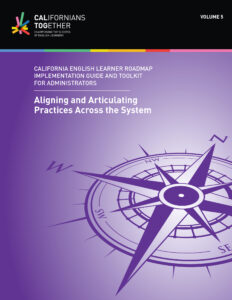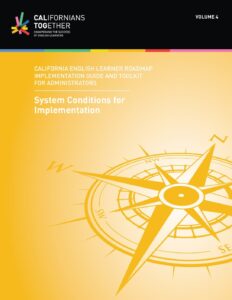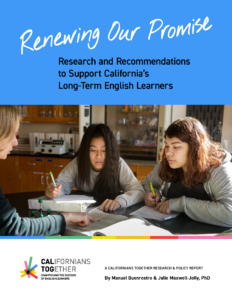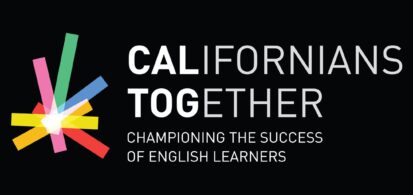Publications
PUBLICATIONS
THE LATEST

CA EL Roadmap Implementation Guide and Toolkit for Administrators Volume 5: Aligning and Articulating Practices Across the System
This fifth and last volume, “Aligning and Articulating Practices Across the System”, focuses on Principle #4 of the CA EL Roadmap policy. Principle #4 is about building an overall system. It guides how to create an aligned and articulated set of practices and pathways across classrooms and school sites, and across grade levels and educational segments that knit together a coherent system of support for English learner success. This final principle ties a bow around the promises and practices of Principle #1 and Principle #2, and ensures equity and consistency throughout the system. It calls for building connections across grade spans, school sites, and components of the schooling system, and creating partnerships beyond schools that make enactment of the full vision and mission possible.
Purchase Copies Download PDF
CA EL Roadmap Implementation Guide and Toolkit for Administrators Volume 4: System Conditions for Implementation
The fourth volume in the EL Roadmap Administrator Toolkit series, “System Conditions for Implementation of the EL Roadmap,” looks at the administrators’ roles in leading the implementation of Principle #3 of the California English Learner Roadmap. This toolkit builds on the other toolkits by centering the role of district and school site leaders in developing a system that supports the research-based, assets-oriented, student responsive, intellectually rich practices called for by the EL Roadmap policy. It focuses on building the local and site policy, guidance, structures, communication, data and assessment practices, staffing, and capacity building that adds up to a system-wide commitment to effective schooling for English learners.
Purchase Copies Download PDF
Renewing Our Promise
By Manuel Buenrostro & Julie Maxwell-Jolly, Ph.D.
Californians Together’s newest LTEL report includes updated LTEL background and outcome information; research landscape summary; review of policy changes; survey results from 107 California school districts with the highest number and/or percentage of LTELs; examples of successful strategies for serving LTEL students and those at risk of being LTELs; and state and local policy recommendations.
Purchase Copies Download Full Report Download Executive Summary Descargar Resumen Ejecutivo
CA EL Roadmap Implementation Guide and Toolkit for Administrators Volume 3: Ensuring the Intellectual Quality of Instruction and Meaningful Access for English Learners
This third toolkit in the CA EL Roadmap Administrators Toolkit series focuses on Principle #2 of the CA EL Roadmap policy. It focuses on instruction, placement, and program – and on the role of district and school site leaders in being able to articulate the effective practices that ensure high-quality instruction and meaningful access for English learners. Similar to the first two toolkits in the Administrators series (I: Leading Implementation of the EL Roadmap and II: Creating Assets-oriented and Needs-responsive Schools), this toolkit focuses on the educators’ role in leading the charge for powerfully meeting the needs of English learners. The first two toolkits are the foundation for leading the implementation of Principle #2.
Purchase Copies Download PDF
Teaching and Learning During Uncertain Times: A Review of Learning Continuity and Attendance Plans
by Conor P. Williams and Manuel Buenrostro
This report draws upon a comprehensive review of Learning Continuity and Attendance Plans (LCPs) from 41 school districts. The districts included in the study were chosen to represent a wide range of communities and settings across the state. For instance, the selected districts spanned 21 counties and enrolled 27 percent of all California K-12 students, as well as 34 percent of the state’s ELs. Nineteen districts enrolled 25,000 or more students, 19 enrolled between 2,500 and 25,000 students, and three enrolled fewer than 2,500. This is a review of the plans, not the implementation of the activities in the plans. The LCPs represent districts’ best intentions but do not include evaluating how well they were implemented.
View Publication
The Accountability System English Learners Deserve: Framework for an Effective and Coherent Accountability System for ELs
The Accountability Framework outlines steps to achieve an effective and coherent accountability system for English learners that support all levels of the state’s educational system. It also provides recommendations for addressing high priority gaps that require urgent action, especially in light of the COVID-19 era. Led by Laurie Olsen Ph.D., the framework was developed by Californians Together and several of its coalition members.
View Publication
A Legacy of Courage and Activism: Stories from the movement for educational access and equity for English Learners in California
by Dr. Laurie Olsen
From movement building to cultivating the next generation of leadership, A Legacy of Courage and Activism by Dr. Laurie Olsen captures and make sense of nearly 70 years of history. The book will be released February 9, 2021 in both physical and electronic formats. Pre-order for physical copies is now available for $29.99 (regular price $34.99) until February 8th exclusively from Californians Together.
Purchase Copies
CA EL Roadmap Implementation Guide and Toolkit for Administrators Volume 2: Creating Assets-Oriented & Student Responsive Schools
This second toolkit in the CA EL Roadmap Administrators Toolkit series focuses on Principle #1 of the CA EL Roadmap policy. It is designed to engage district and school site leaders in understanding and articulating what this “assets-oriented and needs-responsive” principle is about-and the implications for practices, services, and programs at their school and district. Similar to the first toolkit in the Administrators series (Leading Implementation of the EL Roadmap), this toolkit focuses on the educators’ role in leading the charge for the achievement of our goals for English learners.
Purchase Copies Download PDF
CA EL Roadmap Implementation Guide and Toolkit for Administrators Volume 1: Leading Implementation
This Administrators English Learner Roadmap Toolkit series is designed to support administrators as they take up the challenge of leading and supporting the policy’s implementation. There are five volumes in the Toolkit series. Each focuses on a specific aspect of the EL Roadmap, explores the role of administrators related to that component of the policy, provides tools for reflection and planning, incorporates relevant readings, and offers resources administrators can use to support EL Roadmap implementation.
Download PDF Purchase Copies
The LCAP Toolkit: Using research-based tools to ensure equity for English Learners
The LCAP Toolkit: using research-based tools to ensure Equity for English Learners. This toolkit is designed to support school communities in ensuring the academic progress of English Learners by improving our Local Control and Accountability plans (LCAPS). The Center for Equity for English Learners at Loyola Marymount University and Californians Together have created a set of resources to support educators and community members to ensure schools’ efforts to serve English Learners (EL) are not only comprehensive but also visible.
Download PDF Purchase Copies
California English Learner Roadmap: An Elementary School Teacher Toolkit
The English Learner Roadmap Elementary School Teacher Toolkit was written by Dr. Laurie Olsen and Martha Hernández. Teachers from around the state were brought together to help make meaning of the new English Learner state policy. The EL Roadmap Toolkit helps to translate the policy into practice through the lens of the classroom teacher. This Elementary School Toolkit is intended to give teachers tools to reflect on classroom practices and plan for implementation of the California English Learner Roadmap.
Download PDF Purchase Copies Purchase Set
California English Learner Roadmap: A Middle School Teacher Toolkit
The English Learner Roadmap Middle School Teacher Toolkit was written by Dr. Laurie Olsen and Martha Hernández. Teachers from around the state were brought together to help make meaning of the new English Learner state policy. The EL Roadmap Toolkit helps to translate the policy into practice through the lens of the classroom teacher. This Middle School Toolkit is intended to give teachers tools to reflect on classroom practices and plan for implementation of the California English Learner Roadmap.
Download PDF Purchase Copies Purchase Set
California English Learner Roadmap: A High School Teacher Toolkit
The English Learner Roadmap High School Teacher Toolkit was written by Dr. Laurie Olsen and Martha Hernández. Teachers from around the state were brought together to help make meaning of the new English Learner state policy. The EL Roadmap Toolkit helps to translate the policy into practice through the lens of the classroom teacher. This High School Toolkit is intended to give teachers tools to reflect on classroom practices and plan for implementation of the California English Learner Roadmap.
Download PDF Purchase Copies Purchase Set
California English Learner Roadmap: A Guide for Administrators, Coaches, Personnel
The Administrator’s Guidance Document provides suggestions and directions for administrators on how to engage teachers in the implementation of the EL Roadmap.
Download PDF Purchase Copies
Who are the Recipients of the State Seal of Biliteracy?
In California, 418,205 students earned high school diplomas in 2017-18; and 47,248 of those students graduated with a State Seal of Biliteracy, a distinction that recognizes proficiency in English and one or more other languages. This report celebrates the achievement of California’s students who can demonstrate proficiency in multiple languages. It describes the linguistic profiles of the students receiving this recognition and challenges the state to support many more districts and students to participate in the State Seal of Biliteracy Program.
Download PDF Purchase Copies
Who are the Recipients of the Seal of Biliteracy? (infographic)
This infographic is a summary of the important data contained in the report, Who are the Recipients of the State Seal of Biliteracy? Posting this document in schools and districts reminds everyone to celebrate the achievements of the students who earned the State Seal of
Biliteracy and hopefully inspires many more students, schools and districts to participate and honor the languages spoken in California.
Download PDF
Purchase Copies

Masking the Focus on English Learners
Our latest report questions the efficacy of the state accountability system in identifying the needs of English Learners accurately. The report states that by combining data from two English Learner subgroups (current and reclassified), the system masks the distinct needs of each subgroup and diminishes the urgency to address the numerous educational needs of current English Learners thus undermining the central equity intent of the Local Control Funding Formula. The report’s strongest recommendation is that the state discontinue aggregating the two subgroups and instead report them separately for analysis and planning.
Download PDF Purchase CopiesBILITERACY

Who are the Recipients of the State Seal of Biliteracy?
In California, 418,205 students earned high school diplomas in 2017-18; and 47,248 of those students graduated with a State Seal of Biliteracy, a distinction that recognizes proficiency in English and one or more other languages. This report celebrates the achievement of California’s students who can demonstrate proficiency in multiple languages. It describes the linguistic profiles of the students receiving this recognition and challenges the state to support many more districts and students to participate in the State Seal of Biliteracy Program.
Download PDF Purchase Copies
Who are the Recipients of the Seal of Biliteracy? (infographic)
This infographic is a summary of the important data contained in the report, Who are the Recipients of the State Seal of Biliteracy? Posting this document in schools and districts reminds everyone to celebrate the achievements of the students who earned the State Seal of Biliteracy and hopefully inspires many more students, schools and districts to participate and honor the languages spoken in California.
Download PDF Purchase Copies
Multiple Pathways to Biliteracy
This publication describes this new effort as a campaign across California to develop strong, articulated, equitably accessible preschool through high school programs and learning opportunities that will prepare students with high level proficiency in two or more languages. Contained in the document is guidance for districts interested in implementing multiple pathways to biliteracy (K-12) and a description of language learning opportunities and programs for districts to consider.
Download PDF Purchase Copies
Seal of Biliteracy Booklet
This document gives an overview of the State Seal of Biliteracy and locally developed biliteracy pathway awards. In addition to defining the award and the rationale and benefits of bilingualism, this booklet gives suggestions for a step-by-step process to implement these recognitions at the district or school site level.
Download PDF Purchase CopiesCOMMON CORE CONTENT STANDARDS

Raise Your Voices for English Learners: The English Learners and Common Core Advocacy Toolkit
This advocacy toolkit was designed to help ensure that the Common Core is implemented in a way that fully includes English Learners and that meets their unique language development and access needs. It has prepared talking points for use by educators, policy makers, parents and community members in dialogues at the local, district and state levels – raising concerns, pushing for the supports needed to realize the Common Core for English Learners, and advancing the vision of English Learner education that the Common Core can make possible.
Download Background for Toolkit Download Toolkit Palm Card Download Toolkit for Policy Conversations Download Toolkit for Schools and Administrators Download All Purchase Entire Toolkit
English Learner Success in the Common Core State Standards (CCSS): Your Voice, Your Advocacy: A Guide for Parents on How Your Support and the CCSS can Help Your Children Succeed in School
This guide has been developed to help parents understand what the Common Core State Standards (CCSS) are and how these standards will impact the academic success of English learners once they are implemented in the classroom. The guide provides information for parents to use when speaking with their child’s teacher, principal and other school staff to make sure he or she receives the learning supports to succeed academically. It is available in English and Spanish.
Download PDF Purchase CopiesENGLISH LEARNER ROADMAP

California English Learner Roadmap: An Elementary School Teacher Toolkit
The English Learner Roadmap Elementary School Teacher Toolkit was written by Dr. Laurie Olsen and Martha Hernández. Teachers from around the state were brought together to help make meaning of the new English Learner state policy. The EL Roadmap Toolkit helps to translate the policy into practice through the lens of the classroom teacher. This Elementary School Toolkit is intended to give teachers tools to reflect on classroom practices and plan for implementation of the California English Learner Roadmap.
Download PDF Purchase Copies Purchase Set
California English Learner Roadmap: A Middle School Teacher Toolkit
The English Learner Roadmap Middle School Teacher Toolkit was written by Dr. Laurie Olsen and Martha Hernández. Teachers from around the state were brought together to help make meaning of the new English Learner state policy. The EL Roadmap Toolkit helps to translate the policy into practice through the lens of the classroom teacher. This Middle School Toolkit is intended to give teachers tools to reflect on classroom practices and plan for implementation of the California English Learner Roadmap.
Download PDF Purchase Copies Purchase Set
California English Learner Roadmap: A High School Teacher Toolkit
The English Learner Roadmap High School Teacher Toolkit was written by Dr. Laurie Olsen and Martha Hernández. Teachers from around the state were brought together to help make meaning of the new English Learner state policy. The EL Roadmap Toolkit helps to translate the policy into practice through the lens of the classroom teacher. This High School Toolkit is intended to give teachers tools to reflect on classroom practices and plan for implementation of the California English Learner Roadmap.
Download PDF Purchase Copies Purchase Set
California English Learner Roadmap: A Guide for Administrators, Coaches, Personnel
The Administrator’s Guidance Document provides suggestions and directions for administrators on how to engage teachers in the implementation of the EL Roadmap.
Download PDF Purchase CopiesEVERY STUDENT SUCCEEDS ACT (ESSA)

EVERY STUDENTS SUCCEEDS ACT: A Vision to Address the Needs of California’s Youngest Learners
Download PDF Purchase Copies Download PDF
Download PDF
LOCAL CONTROL FUNDING FORMULA (LCFF)

The LCAP Toolkit: Using research-based tools to ensure equity for English Learners
The LCAP Toolkit: using research-based tools to ensure Equity for English Learners. This toolkit is designed to support school communities in ensuring the academic progress of English Learners by improving our Local Control and Accountability plans (LCAPS). The Center for Equity for English Learners at Loyola Marymount University and Californians Together have created a set of resources to support educators and community members to ensure schools’ efforts to serve English Learners (EL) are not only comprehensive but also visible.
Download PDF Purchase Copies
Masking the Focus on English Learners: The Consequences of California’s Accountability System’s Dashboard on Year 4 Local Control and Accountability Plans (LCAPs)
Our latest report Masking the Focus on English Learners questions the efficacy of the state accountability system in identifying the needs of English Learners accurately. The report states that by combining data from two English Learner subgroups (current and reclassified), the system masks the distinct needs of each subgroup and diminishes the urgency to address the numerous educational needs of current English Learners thus undermining the central equity intent of the Local Control Funding Formula. The report’s strongest recommendation is that the state discontinue aggregating the two subgroups and instead report them separately for analysis and planning
Download PDF Purchase Copies
Does Your Local Control Accountability Plan ( LCAP) Deliver on the Promise of Increased or Improved Services to English Learners?: 10 Research-aligned Rubrics to Help Answer the Question and Guide your Program
To provide guidance for LEAs in designing, funding and implementing programs for English Learners using Local Control Funding Formula guidelines, Californians Together, the California Association for Bilingual Education (CABE), California Rural Legal Assistance (CRLA), and the Center for Equity for English Learners (CEEL) developed a set of rubrics that address 10 focus areas with high impact on English Learners. They are: English Language Development, Parent Engagement, Professional Development, Programs and Course Access, Expenditures, District Wide Use of Concentration and Supplemental Grant Funds, School Wide Use of Concentration and Supplemental Grant Funds, Actions and Services, Proportionality, English Learner Data to Inform Goal
Download PDF Purchase Copies
A Review of Year 2 LCAPS: A Weak Response to English Learners
This publication reviewed 29 key school district Local Control Accountability Plans (LCAPs) to determine the impact those LCAPs are having on English Learner students. The report found that LCAPs are distressingly weak in identifying English Learner needs, building capacity to serve English Learners, and supporting the program and services that are responsive to English Learners. Recommendations for districts, county offices and the state are contained in the publication.
Download PDF Purchase Copies
Falling Short on the Promise to English Learners: A Report on Year One LCAPs
This report shares the result of a review of the Local Control Accountability Plans (LCAPs)of 29 key school districts throughout the state, and the impact those LCAPs are having on English Learner students. The report found that LCAPs tend to be characterized by woefully inadequate specificity and weak attention to how schools are meeting the various needs of English Learners. In addition, the study, found that districts tended to not identify effective, research-based practices for working with underserved populations.
Download PDF Purchase Copies Purchase CopiesLONG TERM ENGLISH LEARNERS (LTEL)

Reparable Harm: Fulfilling the Unkept Promise of Educational Opportunity for California’s Long Term English Learners
This report shares data gathered from 40 school districts on English learners grades 6 – 12 and calls upon state policymakers and leaders to provide solutions for these students. It also outlines basic principles and promising approaches for school districts to meet the needs of Long Term English Learners more effectively.
Download PDF Purchase Copies
Secondary Schools Courses Designed to Address the Language Needs and Academic Gaps of Long Term English Learners
Well over half of the secondary school English Learners in California are Long Term English Learners – struggling academically and stuck in progressing towards English proficiency despite six or more years in U.S. schools. Many secondary schools and districts, feeling the urgency of meeting the needs of these Long Term English Learners, are attempting to modify curriculum or create new courses that address the unique language and academic gaps of these students. This report culls the lessons learned from districts throughout the state and provides needed guidance for the field.
Download PDF Purchase Copies Download PDF
Download PDF
 Download PDF
Download PDF
SUPPORT FOR IMMIGRANT AND REFUGEE STUDENTS (SIRS)

Support for Immigrant and Refugee Students
In light of the increasingly hostile climate toward immigrants and the insecurity caused by the changing policy landscape, Californians Together is implementing a multi-pronged approach toward creating a safe learning environment for students of all backgrounds.
Download Entire Toolkit Download Guide for Schools Download Guide for Teachers Download K-2 Lesson Module Download 3-5 Lesson Module Download 6-12 Lesson Module Purchase Entire ToolkitTEACHERS

